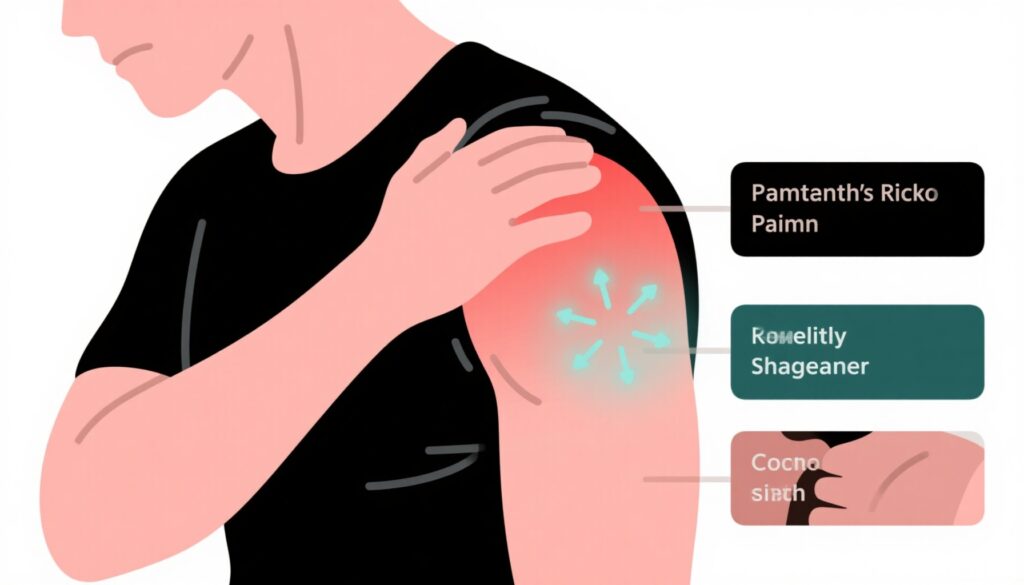Introduction
Shoulder pain is a common complaint that many people experience at some point in their lives. It is often quickly attributed to frozen shoulder (adhesive capsulitis), a condition characterized by stiffness and pain in the shoulder joint. However, shoulder pain in certain areas may indicate other underlying medical issues that require different approaches to treatment. Misdiagnosing these conditions as frozen shoulder can delay proper care and worsen outcomes. This article explores three important diseases that can cause shoulder pain and explains how to distinguish them from frozen shoulder.
Cervical Spondylosis
Cervical spondylosis refers to degenerative changes in the cervical spine (neck region) that can compress nerve roots. Because nerves supplying the shoulder are closely connected to those emerging from the cervical spine, nerve root compression can cause radiating pain in the shoulder area. This pain typically follows the path of the affected nerve and may be accompanied by numbness, tingling, or weakness in the arm.
Pain Location and Characteristics: Pain from cervical spondylosis is usually felt around the shoulder blade near the neck and may feel like a line extending from the neck to the shoulder. It often worsens with neck movements, especially after prolonged activities such as looking down at a phone or computer screen.
Common Treatment Mistakes: Many people assume shoulder pain is due to frozen shoulder and attempt self-treatment with shoulder massages or stretching exercises. However, if the root cause is cervical spondylosis, addressing only the shoulder will not relieve symptoms and may even exacerbate neck damage if inappropriate shoulder movements are performed. Proper management includes cervical spine therapy such as physical therapy, posture correction, and sometimes medications or injections.
Cholecystitis (Gallbladder Inflammation)
The gallbladder and shoulder share sensory nerve pathways that converge at the spinal cord, meaning inflammation in the gallbladder can cause referred pain in the right shoulder. This phenomenon, known as referred pain, occurs when the brain misinterprets signals from the inflamed gallbladder as originating from the shoulder.
Pain Location and Characteristics: Shoulder pain caused by cholecystitis is typically localized to the right shoulder, especially the outer part and the area beneath the right shoulder blade. The pain is often described as a dull ache or a sense of fullness. It may be accompanied by digestive symptoms such as nausea, vomiting, loss of appetite, and right upper abdominal pain.
Common Treatment Mistakes: Because the pain appears in the shoulder, many patients focus solely on shoulder treatment and overlook abdominal symptoms, delaying diagnosis and treatment of cholecystitis. Untreated inflammation can worsen and lead to serious complications like gallbladder perforation. Prompt medical evaluation and appropriate treatment, including antibiotics or surgery, are essential.
Heart Disease
There is a neural connection between the heart and the shoulder region. In cases of heart ischemia or oxygen deprivation, pain signals can be transmitted to the shoulder, causing referred pain. This is especially common in coronary artery disease, where angina (chest pain) can also manifest as pain in the left shoulder, inner left arm, and sometimes the ring and little fingers.
Pain Location and Characteristics: Shoulder pain related to heart disease is most often on the left side and can feel like pressure, tightness, or dull aching. It is commonly accompanied by symptoms such as palpitations, chest tightness, and shortness of breath. The pain usually lasts a few minutes but may recur.
Common Treatment Mistakes: Mistaking heart-related shoulder pain for frozen shoulder is dangerous and can delay life-saving interventions. If unexplained left shoulder pain occurs along with chest symptoms, immediate medical evaluation is critical to rule out heart disease and prevent myocardial infarction or other serious outcomes.
Conclusion
Shoulder pain can signal a variety of health conditions beyond frozen shoulder. Cervical spondylosis, cholecystitis, and heart disease each cause shoulder pain with distinct patterns and associated symptoms. When experiencing shoulder pain, careful attention to the exact location and accompanying signs is crucial. Persistent shoulder pain or pain accompanied by other unusual symptoms warrants timely medical evaluation. Comprehensive diagnosis enables targeted treatment, avoids misdiagnosis, and improves patient outcomes.



